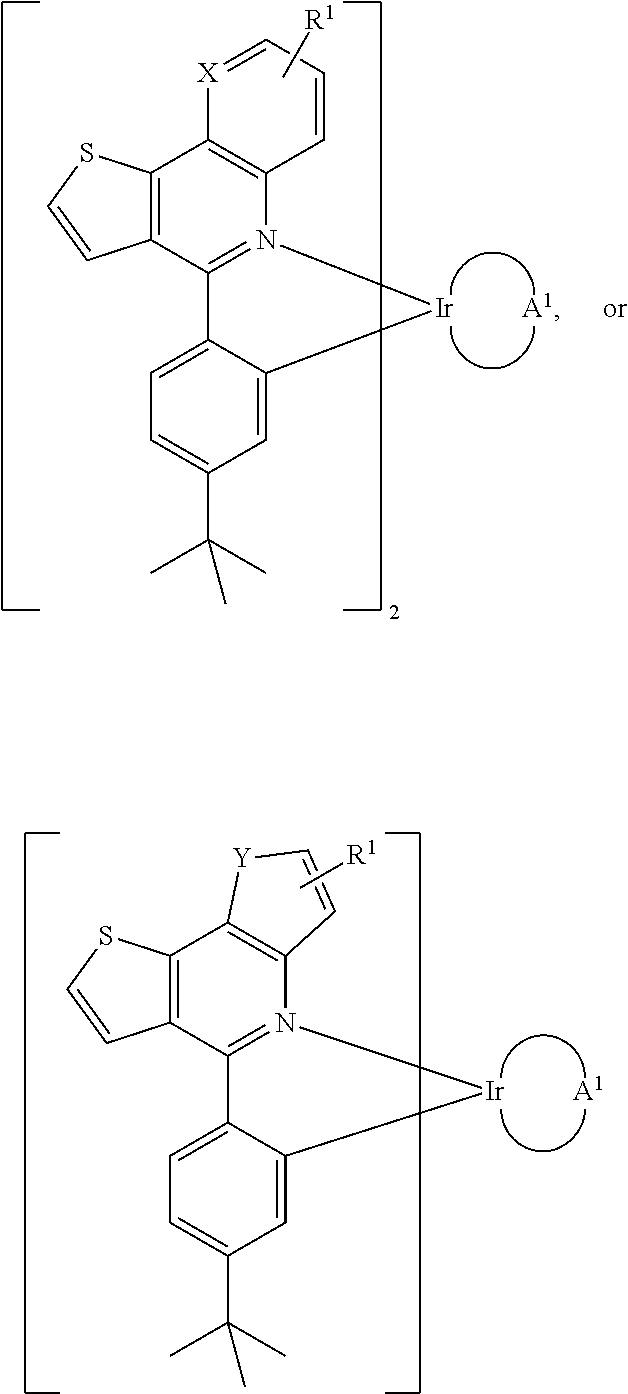Organometallic compound and organic electroluminescence device employing the same
a technology of organic electroluminescence and organic compound, which is applied in the direction of luminescent screen of discharge tube, platinum group organic compound, other domestic articles, etc., can solve the problems of low electroluminescent efficiency, phosphorescent materials, and difficulty in fabricating high cri white electroluminescent device by employing conventional red phosphorescent materials
- Summary
- Abstract
- Description
- Claims
- Application Information
AI Technical Summary
Benefits of technology
Problems solved by technology
Method used
Image
Examples
example 1
Preparation of Compound Ir-THQ-acac
[0026]First, compound (1) (2-(2-aminoethyl)thiophene, 2.0 g, 10.0 mmol) and 50 mL toluene were added into a 250 mL bottle. Next, compound (2) (1.29 g, 10.00 mmole), K2CO3 (2M, 20 mL), Pd(PPH3)4 (0.43 g), and (t-Bu)3P (0.23 g) were added into the bottle at room temperature. After heating to reflux, the NaOH aqueous solution (20%) was added into the bottle and stirred overnight. After purification, compound (3) with a yield of 69% was obtained. The synthesis pathway was as follows:
[0027]Next, compound (3) (1.0 g, 4.90 mmol), Iron powder, a mixed solvent (EtOH:AcOH:H2O=2:2:1, 50 mL) were added into a 250 mL bottle. After heating to reflux for 15 min, the mixture was stirred at room temperature for 25 min. After filtration to remove the Iron powder, the result was neutralized by NaHCO3 and then extracted by ethyl acetate and water. After concentration, compound (4) with a yield of 91% was obtained. The synthesis pathway was as follows:
[0028]Next, compo...
example 2
Preparation of Compound Ir-THO-phac
[0032]First, compound (6) (3.68 g, 11.60 mmol), IrCl3.xH2O (1.65 g), 2-methoxy ethanol (15 mL), and water (5 mL) were added into a 100 mL bottle. After heating to 140° C. for 24 hrs, compound (7)(1.30 g), K2CO3 (0.76 g), and 30 mL 2-methoxyethanol were added into the bottle. After reacting for 24 hrs, the bottle was cooled down to room temperature and the reaction was quenched by adding water (50 mL). The result was purified by column chromatography with n-hexane / dichloromethane (3:1), obtaining Ir-THQ-phac. The synthesis pathway was as follows:
[0033]The physical measurement of the compound Ir-THQ-phac is listed below:
[0034]1H NMR (CDCl3, 200 MHz) δ 8.51 (d, J=5.4 Hz, 2H), 8.45 (d, J=8.8 Hz, 2H), 8.28 (d, J=8.4 Hz, 2H), 8.08 (d, J=7.6 Hz, 2H), 7.71 (d, J=5.4 Hz, 2H), 7.66 (d, J=8.0 Hz, 2H), 7.46 (t, J=8.0 Hz, 2H), 7.41 (d, J=1.8 Hz, 1H), 7.28 (t, J=8.0 Hz, 2H), 7.13 (dd, J=8.0, 1.8 Hz, 2H), 7.03 (dd, J=8.0, 1.8 Hz, 2H), 6.73 (d, J=1.8 Hz, 2H), 1.36...
example 3
Preparation of Compound Ir-THQ-N-acac
[0035]First, compound (1) (2-(2-aminoethyl)thiophene, 2.02 g, 10.0 mmol) and 50 mL toluene were added into a 250 mL bottle. Next, compound (9) (1.29 g, 10.00 mmole), K2CO3 (2M, 20 mL), Pd(PPH3)4 (0.43 g), and (t-Bu)3P (0.23 g) were added into the bottle at room temperature. After heating to reflux, the NaOH aqueous solution (20%) was added into the bottle and stirred overnight. After purification, compound (10) was obtained. The synthesis pathway was as follows:
[0036]Next, compound (10) (1.0 g, 4.90 mmol), lion powder (2.17 g, 38.90 mmol), a mixed solvent (EtOH:AcOH:H2O=2:2:1, 50 mL) were added into a 250 mL bottle. After heating to reflux for 15 min, the mixture was stirred at room temperature for 25 min. After filtration to remove the Iron powder, the result was neutralized by NaHCO3 and then extracted by ethyl acetate and water. After concentration, compound (11) was obtained. The synthesis pathway was as follows:
[0037]Next, compound (11) (1.0...
PUM
| Property | Measurement | Unit |
|---|---|---|
| thickness | aaaaa | aaaaa |
| thickness | aaaaa | aaaaa |
| thickness | aaaaa | aaaaa |
Abstract
Description
Claims
Application Information
 Login to View More
Login to View More - R&D
- Intellectual Property
- Life Sciences
- Materials
- Tech Scout
- Unparalleled Data Quality
- Higher Quality Content
- 60% Fewer Hallucinations
Browse by: Latest US Patents, China's latest patents, Technical Efficacy Thesaurus, Application Domain, Technology Topic, Popular Technical Reports.
© 2025 PatSnap. All rights reserved.Legal|Privacy policy|Modern Slavery Act Transparency Statement|Sitemap|About US| Contact US: help@patsnap.com



